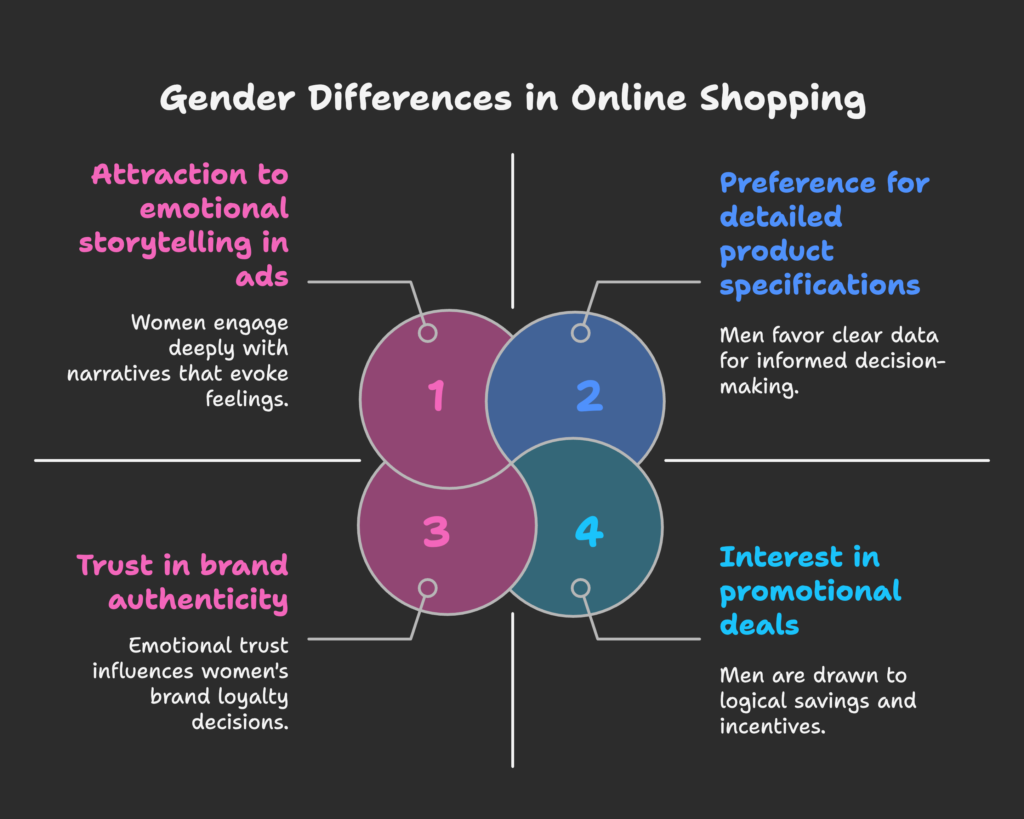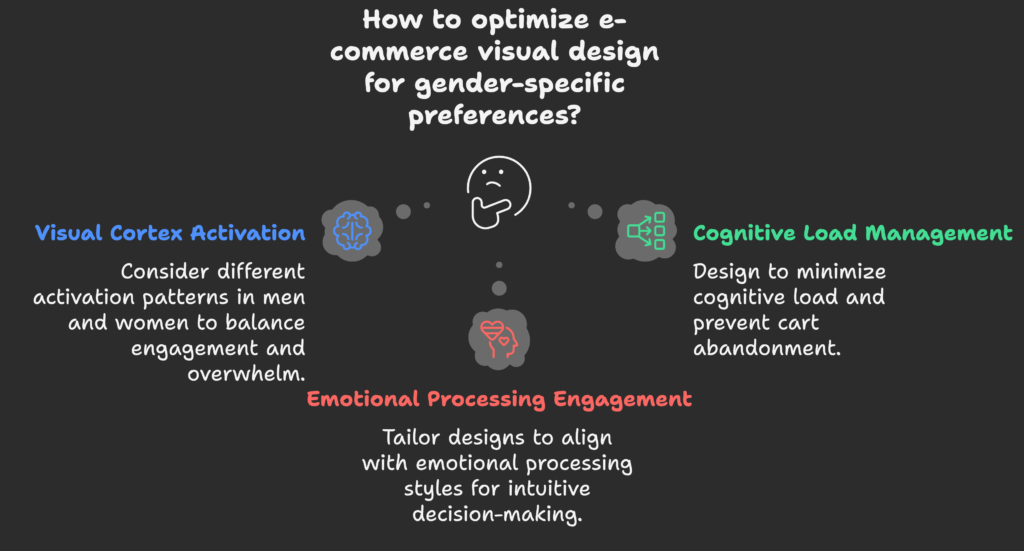Have you ever wondered why a website layout that seems obvious to you might feel confusing to someone else? Or why certain product descriptions spark a stronger emotional pull in one group but not another? By the time you finish reading this article, you’ll discover how the human brain’s wiring can differ between genders, shaping everything from trust in online stores to the way we respond to product images. Ready to explore how neuroscience brings a fresh perspective to e-commerce? Let’s begin!
The Intersection of Neuroscience and E-commerce
In this section, we’ll take a quick look at how neuroscience has become a vital part of the e-commerce world. Neuromarketing—the practice of combining marketing with brain research—offers new ways to measure and understand shopper behavior. When we know more about how the brain processes online experiences, we can design platforms that feel more intuitive and engaging.
We’ve just discovered the growing importance of neuroscience in e-commerce. But why does gender matter in this equation? Let’s find out next.
The Relevance of Gender Differences in E-commerce Neural Processing
Gender differences have been observed in everything from brand loyalty to shopping frequency. Traditional marketing often relied on stereotypes—like “women love browsing” or “men go straight to the deal.” Today, however, neuroscience-based insights reveal that these differences can be tied to distinct patterns of brain activation. This means an online shop can be improved by understanding these patterns instead of relying on outdated stereotypes.
Now that we see why gender plays a key role, let’s move on to the scope of what we aim to understand in this research.
Research Objectives and Scope
In this article, we aim to shed light on the neurobiological reasons behind gender differences in e-commerce. We’ll cover how men’s and women’s brains react to online environments and highlight ways to use these insights for better e-commerce design. Our goal is to give you practical tools you can use in your own digital store.
We’ve set the stage for the journey ahead. Next, let’s dive into the foundational science behind these neural differences.
Neurobiological Foundations of Gender Differences

Structural and Functional Brain Differences Between Genders
Scientists have found that male and female brains can differ in areas such as the corpus callosum, which links the two hemispheres. Some studies suggest that these structural variations may influence how information is shared across the brain. Additionally, gray and white matter distribution can vary, affecting how individuals process visual cues or multitask. Although these distinctions aren’t absolute, they offer a glimpse into why some online experiences might resonate differently with men and women.
You now know some intriguing brain structure facts. Up next, let’s see which specific neural systems come into play when deciding to click “Buy.”
Neural Systems Involved in Consumer Decision-Making
When it comes to online shopping, several brain networks work together. The reward circuitry lights up when we see a deal, emotional centers (like the amygdala) help us decide if we trust a brand, and attention networks track what catches our eye on a busy webpage. Each of these systems can show slightly different activity in men and women, potentially guiding shopping decisions in unique ways.
We’ve covered the core brain systems behind consumer decisions. But how do empathy and reasoning styles factor into all of this? Let’s find out next.
The Empathizing-Systemizing Theory
Proposed by Baron-Cohen, this theory suggests that people generally lean toward either empathizing (focusing on emotions) or systemizing (focusing on structures and rules). Some research indicates that women may score higher on empathizing traits, while men may score higher on systemizing. Applied to e-commerce, this could mean women respond more to emotional product imagery, whereas men might prefer clear specs and data. Such tendencies give us clues on how to design experiences that match different thinking styles.
Now that we’ve explored the neural differences and key theories, it’s time to see how researchers actually study these distinctions in e-commerce settings.
Methodological Approaches to Studying Neural Gender Differences in E-commerce
Neuroimaging Techniques in Consumer Research
Scientists use fMRI to observe real-time brain activation when shoppers browse virtual stores, while EEG measures rapid changes in brain waves to catch subtle reactions. Eye-tracking devices are often integrated to pinpoint exactly where a shopper’s gaze lingers. Each method has its perks and drawbacks, but together, they help us see how differently men and women’s brains engage with digital storefronts.
We’ve learned about the tech behind neuromarketing research. Let’s look at how these methods are applied in real or simulated shopping experiments.
Experimental Paradigms for E-commerce Neural Research
In many studies, participants navigate a simulated online store while researchers track their brain activity. To keep things realistic, certain experiments aim for ecological validity—making digital setups feel like actual shopping scenarios. Researchers also use standardized visual or textual stimuli to compare how genders respond to the same product images or messages. This allows us to spot patterns that might be influenced by brain wiring rather than personal preference alone.
Now that we know how these studies are set up, let’s talk about how researchers analyze and interpret all that neural data.
Data Analysis Approaches for Neural Gender Differences
Statistical techniques help researchers compare activation levels in specific brain regions between men and women. Sometimes, machine learning is used to detect hidden neural signatures that may predict shopping behavior based on gender. Combining brain data with behavioral measures—like how often someone clicks or how long they dwell on a page—offers a fuller picture. Meta-analysis can bring results from multiple studies together, giving a broader perspective on gender differences in online consumer behavior.
You now know how we gather and analyze data about gender and brain activity. Next, let’s zero in on a crucial factor in online shopping: trust.
Gender Differences in Neural Processing of Trust in E-commerce
Neural Correlates of Online Trust
Trust often sparks activity in regions like the ventromedial prefrontal cortex, which helps evaluate risk and reward. The amygdala may also fire up if we sense something suspicious. Men and women can show different levels of activation here, possibly influencing how quickly they trust a new online store or a set of product reviews.
We’ve seen the building blocks of trust in the brain. Let’s look at how these responses differ between men and women.
Gender Variations in Trust-Related Neural Activation
Some research suggests that women activate more brain areas when assessing trust. They might be more attuned to subtle signals—like slight changes in website design or brand tone of voice. Men may rely on more direct cues, such as clear pricing or transparent policies. These variations can influence everything from how quickly a shopper decides to stay on a site to how likely they are to complete a purchase.
Now that we’ve explored these trust variations, let’s dive into the psychological and biological factors driving them.
Psychological and Neurobiological Factors Influencing Gender Differences in Trust
Evolutionary theories suggest that women might be wired to assess social cues more carefully, while hormonal factors like estrogen and testosterone can also shape risk and trust. Culture and upbringing further complicate the picture, proving that gender-related behaviors aren’t universal. Ultimately, individual variations exist within any group, reminding us to avoid one-size-fits-all marketing tactics.
Having covered the science of trust, let’s venture into another visual frontier: website design and how it interacts with gender-specific brain patterns.
Gender-Specific Neural Response to E-commerce Visual Design Elements

Neural Processing of Website Complexity and Visual Design
Studies show that men and women can display different activation patterns in the visual cortex when confronted with complex or cluttered pages. Some might prefer straightforward layouts, while others enjoy more dynamic visuals. The key is to strike a balance—enough excitement to keep users engaged, but not so much that it overwhelms the brain.
We’ve just looked at design complexity. Next, let’s see how gender can influence cognitive load while shopping online.
Cognitive Load and Information Processing Differences
Cognitive load refers to how much mental effort a person needs to understand information. Working memory can be taxed differently in men and women, with one group possibly scanning product data more quickly and the other diving deeper into reviews. High cognitive load can lead to frustration or cart abandonment, so it’s important to design pages that keep tasks smooth and simple.
We’ve now explored the concept of cognitive load. Up next, let’s see how emotional factors tie into these visual design preferences.
Right Hemisphere Engagement in Emotional Processing
Research suggests women sometimes display stronger right hemisphere activity during emotionally charged online interactions. This right-brain engagement can lead to a more intuitive or emotionally driven purchase decision. While men also have emotional responses, they might filter these experiences through more goal-oriented brain networks, potentially giving rise to different shopping styles.
We’ve talked about design preferences and emotional processing. Let’s keep going by exploring how these neural patterns affect product evaluations.
Gender Differences in Product Evaluation Neural Processing
Neural Response to Product Categories and Representations
Specific brain areas can light up differently when viewing certain product types. For example, a female shopper might show heightened activity in reward-related regions when seeing products tied to personal well-being or social connection. Meanwhile, a male shopper might be more drawn to functionality-focused items that trigger a systemizing thought process.
Let’s see what happens when marketing or products are deliberately matched—or mismatched—to a shopper’s gender.
Gender Congruence Effects on Neural Processing
Gender-congruent products and marketing (e.g., ads featuring voices or visuals that match typical gender expectations) can lead to stronger activation in the visual cortex and even the posterior cingulate cortex, which is involved in forming positive attitudes. On the flip side, incongruent messaging can trigger conflict monitoring, causing the brain to re-evaluate what it’s seeing.
Now that we’ve discussed congruence in product representation, let’s dig into how prices are evaluated differently by each gender.
Price Evaluation and Value Assessment Neural Mechanisms
When evaluating price, regions linked to value computation become active. Research shows that some women may be more sensitive to deals, lighting up reward circuits strongly when they spot discounts. Men might focus more on the logical aspect of the price-to-quality ratio, engaging regions of the brain tied to cost-benefit analysis. Both processes play vital roles in shaping purchase decisions.
We’ve uncovered how prices and product fits affect the brain. Next, let’s see how social cues and reviews come into play.
Gender Differences in Social Influence Neural Processing
Neural Response to Reviews and Social Proof
Online ratings and testimonials can light up social influence networks in the brain, driving trust and purchase intent. Women may be more responsive to the emotional tone in peer reviews, while men might look for logical evidence like data or facts. Both groups, however, rely on neural circuits that gauge credibility and authenticity when reading reviews.
We’ve seen how shoppers respond to social proof. Next, let’s discuss social media factors and community aspects.
Social Media Integration and Community Aspects
Social media signals, such as likes and shares, can spark activity in brain regions tied to community belonging. Men and women might differ in how they process these cues, with some focusing on group validation and others using social content as a way to find practical information. This mix of emotional and rational processing reveals why social media remains a powerful driver of e-commerce engagement.
Up next: brand perception. Let’s uncover how genders differ in how they connect with brands at the neural level.
Neural Correlates of Brand Perception
Brands with a strong emotional identity can tap into the brain’s emotional-processing areas more deeply, which may resonate more with female shoppers if these brands emphasize empathy. Men, on the other hand, might respond strongly to brands with clear, systemized values like innovation or technical excellence. Knowing these patterns helps marketers design brand messages that speak to diverse audiences.
We’ve now explored the social side of shopping. Let’s jump into the difference between practical and pleasure-driven shopping motivations.
Utilitarian Versus Hedonic Shopping Neural Patterns
Neural Circuits Supporting Different Shopping Motivations
Utilitarian shopping often lights up areas associated with task completion and reward centers that activate once the task is done. Hedonic shopping, focusing on fun and excitement, might stimulate additional reward pathways and emotional circuits. Men and women can show a range in both styles, but gender can tip the balance in how strongly one style is preferred over the other.
We’ve seen the functional differences. Next, let’s see how goals and exploration factor into these neural circuits.
Goal-Directed Versus Exploratory Neural Mechanisms
Men may be more prone to goal-directed behavior, diving straight into the site to find what they need. Women might engage in more exploratory browsing, enjoying the discovery process. These distinctions reflect how each gender’s brain may switch between logic-focused and curiosity-driven modes. Both approaches have their strengths in e-commerce, depending on the task.
Next, we’ll look at how the brain’s reward system itself varies between genders during the shopping experience.
Reward Processing Variations Between Genders
The dopaminergic reward system can fire differently when men and women anticipate a purchase. Women might feel more anticipatory excitement, while men might experience a burst of satisfaction once the item is secured. Understanding these variations helps in timing promotions and offers in ways that resonate with both groups.
We’ve covered shopping motivations from all angles. Next, let’s talk about how these differences appear on mobile devices.
Mobile E-commerce and Cross-Device Neural Processing
Neural Adaptations to Mobile Shopping Interfaces
Mobile screens are smaller and demand more focused attention. Men and women might handle this visual constraint differently based on how their brains process details. Some studies suggest that navigation and user interface elements can create more cognitive load for one gender than the other. Ensuring simple and responsive mobile design can help reduce these challenges.
We’ve introduced mobile interface challenges. Next, let’s see how the brain deals with switching between devices.
Cross-Device Shopping Journey Neural Patterns
When shoppers move from a laptop to a smartphone, their brains must adapt. Women may pay more attention to maintaining consistent emotional connections across devices, while men might focus on continuing a logical shopping path without distractions. Providing a seamless journey supports both styles, leading to fewer abandoned carts and more satisfied customers.
Finally, let’s zoom in on how mobile-specific experiences shape each gender’s neural processing.
Mobile-Specific Gender Variations in Neural Processing
Surprisingly, some data shows men are more likely to finish purchases on their phones, potentially reflecting higher confidence in quick decision-making. Women, however, might engage in more thorough comparisons before tapping “Buy.” Recognizing these differences can inform mobile design strategies that cater to each group’s comfort levels and preferences.
We’ve now explored mobile shopping. Next, let’s pull everything together to see how we can apply these insights in real-world e-commerce design.
Practical Applications for E-commerce Design
Neuroscience-Informed Website Design Strategies
A one-size-fits-all approach can leave both men and women disengaged. It’s helpful to combine clear navigation for task-oriented shoppers with inviting visuals for those who want a more immersive experience. Use strong headings, short paragraphs, and straightforward menus so users don’t get lost. Small tweaks, like adjusting color contrast or simplifying layout, can dramatically improve engagement for everyone.
We’ve covered broad design strategies. Up next, let’s see how you can personalize experiences even further.
Personalization Approaches Based on Neural Processing Differences
Advanced systems can adapt content in real time, showing more data-driven details to those who prefer facts and more emotional stories to those who enjoy narratives. Personalization engines, fueled by machine learning, may also use buying histories and on-site behaviors to predict which approach resonates best with each visitor, respecting unique neural preferences.
We’ve discussed personalized designs. Now, let’s talk about building trust through neural insights.
Trust-Building Elements Informed by Neural Research
Highlighting safety features and reviews can activate the brain’s trust circuits. Men might appreciate clearly stated policies and logical return processes, while women may respond strongly to community feedback and social proof. Incorporating risk-reduction strategies—like money-back guarantees—can also help reassure shoppers across genders.
We’ve learned how to foster trust. Now let’s see how to test and validate these neuroscience-based e-commerce designs.
Testing and Validation Methodologies
By running A/B tests, you can see which design or messaging approach leads to better engagement and conversions. Integrating neural measures, such as brainwave monitoring or even simpler biometrics like eye-tracking, can give deeper insight into why a certain design works. Over time, these findings can guide continuous improvements to your online store.
We’ve covered practical steps you can take right away. Next, let’s explore how AI is helping to reduce biases in e-commerce.
Addressing Bias Through AI and Technology
AI Applications in Gender-Neutral E-commerce
AI-driven algorithms can catch and correct patterns that might unintentionally reinforce gender biases, such as offering certain products only to women or describing items differently for men. This helps create a more welcoming environment for all, removing unnecessary barriers or stereotypes in product recommendations and pricing strategies.
We’ve seen how AI helps curb bias. Next, let’s discuss the ethics of using neuromarketing insights responsibly.
Ethical Implementation of Neuromarketing Insights
While neuromarketing offers valuable data, it’s essential not to misuse it. Exploiting vulnerabilities or over-personalizing can breach consumer trust. Being transparent about how data is collected and used keeps shoppers informed and comfortable, ensuring that both retailers and customers benefit ethically from these innovations.
We’ve addressed ethics. Now, let’s look at future directions in neuroscience-based e-commerce.
Future Directions in Neuroscience-Informed E-commerce
With continuous advances in mobile imaging and wearable tech, real-time neural feedback could become part of everyday online shopping. Stores might adapt to your brain activity on the fly, changing layouts or offering personalized deals. Integrating other biological markers, like heart rate or skin conductance, may also offer more nuanced insights for even better user experiences.
We’ve taken a peek at the future. Before we wrap up, let’s explore the challenges and limitations in current research.
Methodological Challenges and Limitations
Limitations of Current Neuroimaging Approaches
While fMRI provides detailed data, it’s expensive and requires participants to lie still, limiting how “real” the shopping scenario can be. EEG is more flexible but less precise about pinpointing deep brain regions. Small sample sizes can also skew findings, making it risky to generalize too broadly.
We’ve discovered some method challenges. Next, let’s talk about the nuances of using a gender binary in research.
Issues in Gender Binary Approaches
Not everyone fits neatly into “male” or “female” categories. Cultural factors, personal identity, and individual brain differences can blur these lines. Over-reliance on binary views might miss key insights into diverse shopping behaviors. Moving toward a broader view of gender can enrich neuromarketing research.
We’ve considered the binary limitation. Let’s close this section by touching on ethical concerns.
Ethical Considerations in Gender-Based Neural Research
Focusing on gender differences could accidentally reinforce stereotypes if not handled thoughtfully. Researchers must keep consumer privacy and consent top of mind when collecting brain data. There’s a delicate balance between commercial goals and the responsibility to respect each individual’s complexity and autonomy.
We’ve tackled the biggest caveats and concerns. Let’s conclude our journey with a final summary and a look at what the future may hold.
Conclusion and Future Research Directions
Synthesis of Key Findings on Gender Differences
We’ve seen that structural, functional, and emotional factors in the brain all play roles in how men and women navigate e-commerce. Applying these insights can help create designs that feel inclusive, intuitive, and trustworthy. However, remember that individual variations exist, so we shouldn’t treat gender as a one-size-fits-all label.
We’ve tied the major themes together. Now, let’s see what’s on the horizon for neuromarketing.
Emerging Trends in Neuromarketing Research
Future studies might incorporate multiple measurement techniques—like combining eye-tracking with hormones or genetic markers. Wearable sensors that measure brain waves in real time could become more accessible, allowing for more naturalistic online shopping experiments. Big data analytics may also help refine personalization, ensuring shoppers see offers that match their unique neural preferences.
Finally, let’s wrap up with how researchers can build on what we’ve learned.
Recommendations for Future Research
We can expand our understanding of gender differences by conducting longitudinal studies to see how shopping habits evolve. Cross-cultural research will also provide a more global perspective on how social factors shape neural patterns. Standardized protocols for measuring brain activity in e-commerce could help unify findings, while exploring hormonal or genetic influences may reveal new insights into how shoppers think and feel.
References
- Riedl, R., Hubert, M., & Kenning, P. (2010). Are There Neural Gender Differences in Online Trust? An fMRI Study on the Perceived Trustworthiness of eBay Offers. MIS Quarterly, 34(2), 397-428. https://misq.umn.edu/are-there-neural-gender-differences-in-online-trust-an-fmri-study-on-the-perceived-trustworthiness-of-ebay-offers.html3
- Anonymous. (2022, May 16). He thought, she bought: Males and females activate different brain regions when shopping online. The Academic. https://theacademic.com/he-thought-she-bought-males-and-females-activate-different-brain-regions-when-shopping-online/8
- Zoovu. (2024, April 26). Women vs. Men: Gender Differences in Purchase Decision Making. Zoovu Blog. https://blog.zoovu.com/women-vs-men-gender-differences-in-purchase-decision-making/4
- Anonymous. (2018, July 2). Neural correlates of gender congruence in audiovisual commercials for gender-targeted products: An fMRI study. PubMed Central. https://pmc.ncbi.nlm.nih.gov/articles/PMC6866533/5
- Bačíková, Z., & Fedorko, R. (n.d.). Gender Differences in Consumers Perception of Neuromarketing. International Business Information Management Association. https://ibima.org/accepted-paper/gender-differences-in-consumers-perception-of-neuromarketing/6
- Anonymous. (2018, December 31). Gender-Based iTrust in E-Commerce: The Moderating Role of Cognitive Innovativeness. MDPI. https://www.mdpi.com/2071-1050/11/1/1757
- Womentech. (2024, February 27). How Is AI Being Used to Combat Gender Bias in E-Commerce? WomenTech Network. https://www.womentech.net/en-fr/how-to/how-ai-being-used-combat-gender-bias-in-e-commerce1
- Rybanská, J., Košičiarová, I., & Nagyová, Ľ. (2021, June 9). Consumer Purchasing Behaviour and Neuromarketing in The Context of Gender Differences. Journal of Marketing Research and Case Studies. https://ibimapublishing.com/articles/JMRCS/2021/321466/321466.pdf2
- Kahneman, D., Knetsch, J. L., & Thaler, R. H. (2020). The Endowment Effect and Beliefs About the Market. PMC. https://pmc.ncbi.nlm.nih.gov/articles/PMC7983076/
- Baron-Cohen, S. (2002). The extreme male brain theory of autism. Trends in Cognitive Sciences, 6(6), 248-254.
- Venkatraman, V., Dimoka, A., Pavlou, P. A., Vo, K., Hampton, W., Bollinger, B., Hershfield, H. E., Ishihara, M., & Winer, R. S. (2015). Predicting advertising success beyond traditional measures: New insights from neurophysiological methods and market response modeling. Journal of Marketing Research, 52(4), 436-452.
- Knutson, B., Rick, S., Wimmer, G. E., Prelec, D., & Loewenstein, G. (2007). Neural predictors of purchases. Neuron, 53(1), 147-156.
- Plassmann, H., O’Doherty, J., Shiv, B., & Rangel, A. (2008). Marketing actions can modulate neural representations of experienced pleasantness. Proceedings of the National Academy of Sciences, 105(3), 1050-1054.
- Solnais, C., Andreu-Perez, J., Sánchez-Fernández, J., & Andréu-Abela, J. (2013). The contribution of neuroscience to consumer research: A conceptual framework and empirical review. Journal of Economic Psychology, 36, 68-81.
- Darlow, S. D., & Sloman, S. A. (2010). Two systems of reasoning: architecture and relation to emotion. Wiley Interdisciplinary Reviews: Cognitive Science, 1(3), 382-392.
Quick Reminder for Shopify Stores: If you’re running a Shopify store and want a practical way to boost sales, consider using a Growth Suite app. It can help you apply some of these neuromarketing insights—like personalized recommendations and trust-building features—so you reach both male and female customers more effectively. Why not give it a try and see how your conversions improve?



